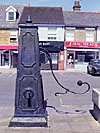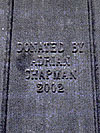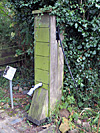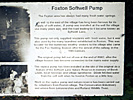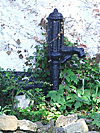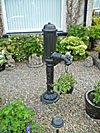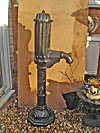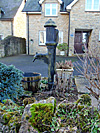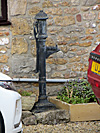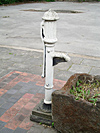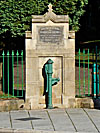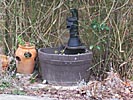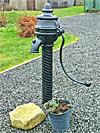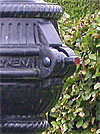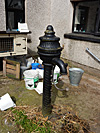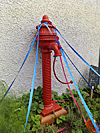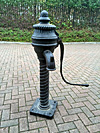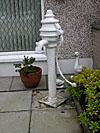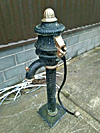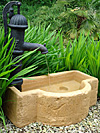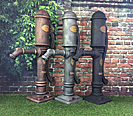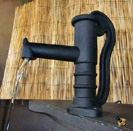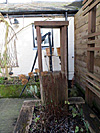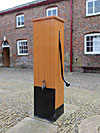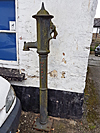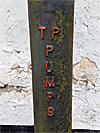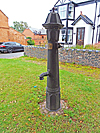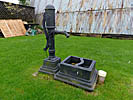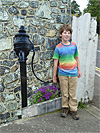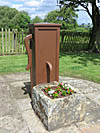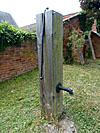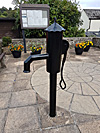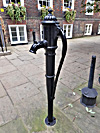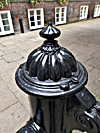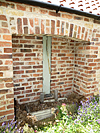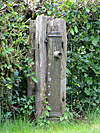| And some that are
initially thought to be pumps turn out to be anything but: |
|
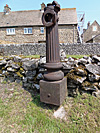 |
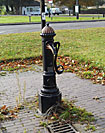 |
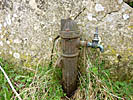 |
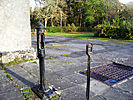 |
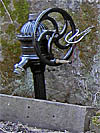 |
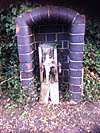 |
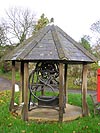 |
A probable stinkpipe/
stenchpipe at
Monyash, Derbs?
Thanks to Mike Woolford for the photo. |
This one at Glinton,
Peterborough, isn't a pump, but a water pillar, connected to the water mains.
An instruction plate explains that the handle needs to be pushed down in order
to depress a valve plunger. John Hurst reminds us that there's a similar one on
the quayside at St. Ives, Cambs.
Manufacturer's information used to be at
http://www.ajbernasconi-design.co.uk/021.html,
but the link no longer works. |
After some deliberation, we've concluded that this device, at
Ulwell, Dorset, made by Guest & Chrimes of Rotherham & London, is in
fact a water pillar. Thanks to Mike Faherty for the photo. |
A weighing machine at Blackpool Mill, Pembs. Thanks to Ruth
Roberts for the photo. |
This apparent pump at Rickford, N. Soms is in fact a form of
hydrant - the wheel carries the wording "OPEN/SHUT", which implies that it
controls a valve and hence water under pressure. Thanks to Neil Owen for the
photo. |
This device in Stetchworth High St, Essex, looks suspiciously like
a water pillar. Thanks to Bob Taylor for the photo. |
The impressive wheeled structure at Anstey, Herts - but a
close-up of the mechanism - thanks to John Hurst
- shows that it's a well-head winding gear, not a pump. Research shows that
there used to be an identical one at Cottered, Herts. Main picture used with
permission from: http://www.soil-net.com/album/Water/Drinking_Water/.
|
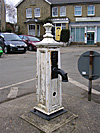 |
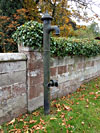 |
Click here to
see pic I've
taken from
www.geograph.
org.uk's site. |
Click here to
see pic I've
taken from
www.geograph.
org.uk's site. |
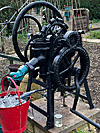 |
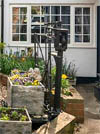 |
|
A water
pillar at Corby Glen, Lincs, and there's another similar one in the High St.
Elsewhere there's the comment "The water supply was improved by W. H. Woodhouse
of Irnham Hall, bringing it from a spring to standpipes".
Thanks to Bob Harvey for clarification that "the water supply was
gravity fed from a brick lined open topped tank further up the hill toward
Irnham, which does not survive. That was fed, in turn, by a natural
spring. Thanks to Joan Deane for the photo. |
A double-spouter at Claverley, Shrops, but it's not what it
seems. There's no sign of a fulcrum nor of any other mounting device for a
handle - or indeed any room for one above the upper spout, where it would have
had to have been. The hole piercing the barrel at right angles to the lower
spout is puzzling, too.
But the old maps do show a pump at this location, and it does seem
to include some genuine pump parts. Nevertheless, the conclusion is that this
structure was almost certainly a standpipe, connected to the nearby mains
supply, which is indicated by a yellow hydrant cover in the road. Thanks to
John Hurst for the photo and for checking things out. |
A water
pillar at Tidenham, Glos. |
A water
pillar at Idlicote, Warks. |
This
"water lifter" in Bourton-on-the-Water, Glos, is a bit of home-made whimsy,
driven by a small electric pump. |
It
certainly looks like a pump from a distance, but it's an ancient weighing
machine in Dunwich, Suffolk, and we've been tricked by these devices more than
once before - see above. Thanks to Gill Tovey for the photo. |
|
